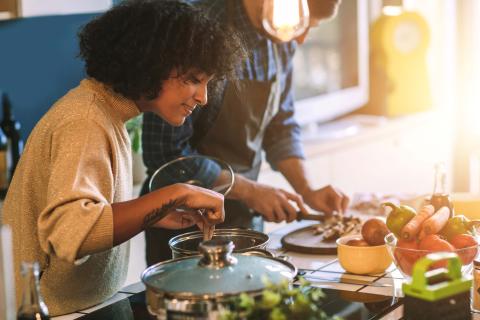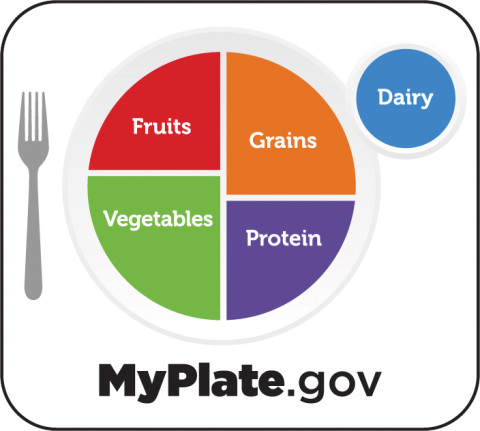
Welcome to our 5-ingredient meals series! When you are in a pinch for time, or just want something simple, planning a meal with only five ingredients can be a great option. Let’s start by learning how to use MyPlate to plan quick meals. Then, we’ll discuss making sure your meals are prepared safely.
MyPlate Overview
 MyPlate is a tool that shows how to balance the five food groups throughout the day. The five food groups are: vegetables, fruit, grains, protein, and dairy. In an ideal world, your plate might look like the MyPlate at each meal, but it’s more likely that the MyPlate will be a good guide to help you shape your meals and snacks to include a variety of the food groups shown and in similar proportions throughout your whole day.
MyPlate is a tool that shows how to balance the five food groups throughout the day. The five food groups are: vegetables, fruit, grains, protein, and dairy. In an ideal world, your plate might look like the MyPlate at each meal, but it’s more likely that the MyPlate will be a good guide to help you shape your meals and snacks to include a variety of the food groups shown and in similar proportions throughout your whole day.
Vegetables and fruits can be added to your plate in a variety of ways. According to MyPlate half of our meals should be made up of fruits and vegetables. These foods can be fresh, frozen, dried, juiced, or canned. For canned vegetables look for “low sodium” or “no salt” labels. For canned fruit look for labels that say “100% fruit juice,” as those will be the better option than canned fruit with heavy syrup When planning your 5 ingredient meals, think of ways to incorporate fruits and vegetables into the recipe or as a quick side to go with your meal.
The Grains group includes food like wheat, oats, rice, and barley. Grains are a great source of carbohydrates, which our body uses for energy. There are many options for grains, which add more fiber to your meals. Whole wheat bread, oatmeal, brown rice, corn tortillas, or even quinoa are some that can be easily incorporated into your meals.
Protein foods include both meat and vegetable-based choices. Lean or lower-fat options are more heart healthy, such as lean or extra-lean ground beef, and skinless chicken. Protein can be the focus of the meal, like baked chicken breast and vegetables or it can be added as a side, such as baked chickpeas on top of a salad. Looking for plant-based options? Tofu, beans, and nuts are great sources of protein and fiber!
Dairy is the blue circle to the side of MyPlate. This group is all about calcium. Milk and many foods made from milk are part of the dairy group. Soymilk and other milk alternatives are also part of the Dairy group if it is fortified with calcium (calcium added).
Including one ingredient from each category can be a useful practice when creating a meal. In fact, many 5-ingredient meals do just that! For instance, many pasta dishes and salads use one to two ingredients from each category to make a simple meal. Here are some recipes from our site that do just that: Chickpea, Tomato, and Spinach Pasta or Bean Salad with Rice.
Food Safety
Even with the simplest recipes, it's important to remember safe food practices. Here is a safety checklist to include in your meal preparation.
- Always wash your hands before you start cooking in the kitchen.
- Wash fresh fruits and vegetables before you prepare and eat them.
- Do not wash raw meats, such as chicken or turkey. Cooking meats hot enough will kill the bacteria and other germs. Washing raw meat can splash germs onto other parts of your kitchen.
- When handling raw meats for cooking, make sure to wash your hands and any surface after you a done with preparations, such as knives, countertops, and cutting boards.
- Use a different cutting board and utensils for raw meats than you use for vegetables, fruits, and anything you won’t be cooking.
- Also use different utensils for cooked meat than you use for raw meat.
- Make sure to cook food to the correct temperature. Check our table below to see what temperature you need to use for different kinds of meat.
| Food Item | Recommended Temperature |
|---|---|
| Ground Beef or Pork | 160 |
| Ground Turkey or Chicken | 165 |
| Sausage | 165 |
| Fresh Beef or Pork(steaks, roasts, or chops) | 145 and rest for 3 minutes |
| Whole Chicken or Turkey | 165 |
| Chicken or Turkey Breasts or Roasts | 165 |
| Eggs | Cook until both yolk and white are firm |
| Leftover Dishes | 165 |
Source: USDA Food Safety and Inspection Service
Storing
When it comes to storing leftovers there are four things to remember:
- Let your food cool before packaging it in a container.
- Don’t let your food sit out for more than 2 hours before putting it in the fridge. If you are outside and the weather is 90 degrees or above, put leftovers in the fridge within an hour.
- Find a freezer or refrigerator safe container that seals well.
- Store in a refrigerator for up to 3-4 days and in the freezer for up to 3 months.
Defrosting
To safely defrost your food, remove it from the freezer and place it in your refrigerator the day before you plan to eat it. Then reheat as you normally would. Forgotten to take your food out of the refrigerator? There are a few other ways you can safely defrost your food.
- Microwave: Use the “defrost” button on your microwave until the item has been defrosted.
- Cold Water: This method works better if the item is in a plastic airtight container. Put the item in a bowl in the sink with cold tap water, replace the water every 30 minutes until the item is defrosted.
Now that we have gone through some best practices for safely cooking, storing, and defrosting your meals, we can start to plan our 5-ingredient meals.
Sneak Peak for next post: Build Your Own Charcuterie Boards: Five Ingredients, One Board!

